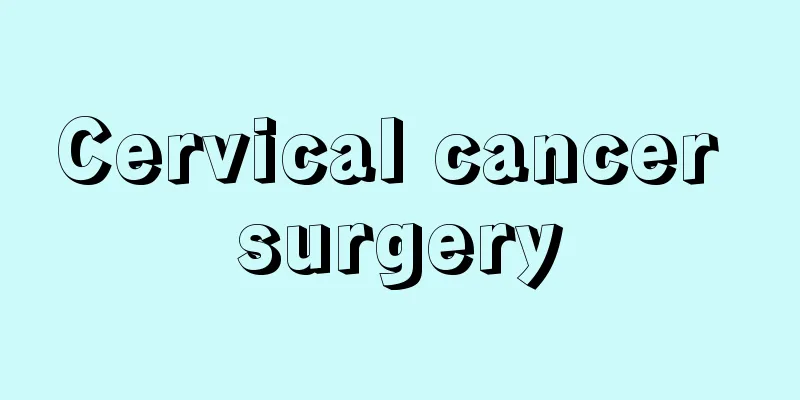Cervical cancer surgery

|
Cervical tumor surgery requires patients to choose a regular large hospital for surgery, which can reduce the risks and side effects of the surgery. After the cervical tumor surgery, attention should be paid to vaginal hygiene, because vaginal bleeding and urination pain will occur after the surgery. Therefore, patients should take medication according to the advice of their doctor. Small cervical tumors can be treated directly with drugs without surgery. 1. Does cervical fibroids require surgery? Not all uterine fibroids require surgery. If the uterus is compared to a room, the walls inside the room are covered with a layer of soil (the endometrium, which falls off once a month and causes menstruation), and fibroids will grow inside and outside the room and between the walls. Generally speaking, the treatment method is determined based on the patient's age, whether or not they want to have children, whether or not they have symptoms, and the location and size of the fibroids. If the patient's fibroids are small and asymptomatic, follow-up can be chosen and no drug treatment is necessary. It is generally believed that surgical treatment should be given when the following seven situations occur: fibroids compress the bladder and rectum, causing frequent urination, constipation or difficulty in defecation; fibroids cause excessive menstrual flow, leading to secondary anemia, and drug treatment is ineffective; acute abdominal pain occurs when the pedicle of a pedunculated fibroid is twisted; uterine fibroids grow rapidly, and the possibility of malignancy cannot be ruled out; uterine fibroids affect fertility or cause recurrent miscarriages; uterine fibroids are difficult to distinguish from ovarian tumors and require surgical differential diagnosis; fibroids do not shrink but increase after menopause, or new uterine fibroids are discovered (patients who have not been given estrogen replacement therapy). 2. Causes of cervical fibroids The exact cause of uterine fibroids is unknown, but it may be related to excessively high estrogen levels in the body and long-term estrogen stimulation. It is occasionally seen in women after menarche, but more common in middle-aged women. After menopause, fibroids usually stop growing and gradually shrink. Fibroids are often complicated by endometrial hyperplasia. Patients with ovarian granulosa cell tumors and theca cell tumors (which can secrete estrogen) often have uterine fibroids. During pregnancy, estrogen levels increase and fibroids often grow rapidly. Exogenous estrogen can accelerate the growth of fibroids. 3. Clinical manifestations of cervical fibroids The main symptoms are irregular menstruation, increased menstrual blood volume, increased leucorrhea or bladder and rectal symptoms. Some patients have no symptoms. Gynecological examinations may reveal protruding myoma nodules in the cervix or changes in the shape of the cervix. The cervix on the side where the myoma is located is enlarged, while the opposite side is compressed and thinned, and the external cervical opening is stretched and flattened into a twist shape. What to eat for cervical fibroids 1. Eat dried fruits. Patients with uterine fibroids can eat more nutritious dried fruits such as sunflower seeds, black and white sesame seeds, peanuts, etc., which are easy to eat and taste good. 2. Eat poultry eggs. Fresh chicken and eggs are particularly beneficial for patients with uterine fibroids, especially those who have undergone uterine fibroid surgery. They not only help wound healing, but also nourish the body at the same time. 3. Eat fruits. Experts point out that the fructose and natural vitamins contained in fruits cannot be replaced by various vitamin effervescent tablets and other medicines. Eating more fruits is very helpful for the physical and mental health of patients with uterine fibroids. However, experts also specifically support that it is best to eat seasonal fruits. Fruits that are artificially ripened or grown in greenhouses contain hormones, which are not conducive to the recovery and treatment of patients with uterine fibroids. 4. Eat vegetables. Two types of vegetables are most suitable for patients with uterine fibroids. One is melon vegetables, such as winter melon, cucumber, etc., and the other is green leafy vegetables, such as spinach, cabbage, celery, etc. |
>>: Are uterine tumors serious?
Recommend
Can pregnant women wash their feet and massage
Women's physical and mental health are subjec...
What causes nipple pain during pregnancy
Pregnancy is a very special period. Any slight ch...
Precautions for red spots on female urethra
Gynecological diseases occur frequently in life, ...
Can pregnant women eat Sanhua plums?
Sanhua plums have a crisp taste and sweet and sou...
Are pregnancy tests accurate?
In the past, people didn’t have condoms, so they ...
Practical post! "From prevention to treatment" knee protection experts explain knee osteoarthritis in detail
Arthritis is one of the most common chronic joint...
How to treat cough during pregnancy?
What should pregnant women do if they cough durin...
A lot of blood clots were discharged after the abortion
Medical abortion is a common method of abortion a...
The new coronavirus is frequently detected on the outer packaging of cold chain food. Can frozen fresh food still be eaten?
The coronavirus has been frequently detected on t...
How to reduce breast size for girls easily
Some girls have always simply thought that big br...
How long does it take to give birth to the first baby in the delivery room?
The time of delivery for a pregnant woman enterin...
Old knowledge and new evidence on "periconceptional folic acid supplementation"
Author: Yan Weili Professor and Researcher, Child...
Does high uric acid affect pregnancy?
High uric acid levels are a genetic metabolic dis...
What are the benefits of women drinking milk powder?
Milk powder is something that can supplement nutr...
Can I do yoga during menstruation?
Every female friend of ours will have menstruatio...









